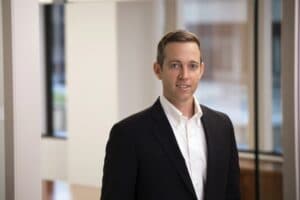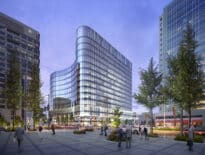Ryan McDonough
Principal and Boston regional acquisitions director, Marcus Partners
Age: 40
Industry experience: 17 years
Ryan McDonough has $360 million in fresh equity commitments from institutions and high net worth sources to invest in East Coast commercial real estate. McDonough oversees acquisitions for Boston-based Marcus Partners, which last week announced the closing of its latest investment vehicle, Marcus Capital Partners Fund III. The firm plans to acquire office, medical office, industrial, life science and multifamily properties in the Boston, New York City and Washington, D.C. markets. The fund has already made a high-profile deal in Boston’s Seaport District, acquiring the Au Bon Pain headquarters and bakery with plans for a 228,000-square-foot office-lab complex. McDonough joined Marcus Partners in 2017 after a stint at Bentall Kennedy, overseeing its acquisition of six office buildings and three parking garages in the Seaport District.
Q: In your previous role at Bentall Kennedy acquiring properties including parking garages in Boston, what went into the analysis of whether to redevelop the property or maintain the existing use?
A: What was unique about buying parking garages at the time in the 2014 and 2015 timeframe was there was a parking freeze in South Boston. It’s unique in real estate to have that kind of artificial barrier to entry. We saw everything going on in the office market, and the potential to build income. At 22 Boston Wharf Road, you had a parking garage with two floors of office and the ability to add two stories of office [in a vertical addition] in a market that was tight. There was a baseline of cash flow with a value-add proposition. Part of it was you could control all the garages and really drive prices.
Q: Which fund is Marcus Partners using to buy its recent acquisitions?
A: Our Fund II is fully invested and we are now investing Fund III, which is $360 million, and we’ve been investing predominantly in life science and industrial properties with that fund. We are investing in offices, industrial, life science, medical offices and multifamily in Boston, New York City and Washington, D.C.
Q: What made the Au Bon Pain property in the marine industrial park an attractive acquisition?
A: We also [have under agreement] 310 Northern Ave. in the Seaport, so for us, it’s a situation where we’re very comfortable in that submarket. We like the long-term life science play and the clustering you’re seeing there. To us, the Seaport’s probably the next step down from Kendall Square. You’re seeing a ton of leasing and capital sources come in there, and really helping the expansion. We recognize the Seaport has its challenges from an access perspective, but the tenant interest has been great and the access to the Pike and Interstate 93 speaks for itself.
Q: How do you think demand for office space will compare with pre-pandemic levels?
A: In 2017, we decide to pivot a percentage out of office and into industrial, life science and multifamily. I’ll speak for myself: office probably needs to be repriced. With the work-from-home phenomenon, there’s going to be negative net demand. It’s hard to argue against that. In those markets that are tech-heavy, young people want to be in an office, whether it’s for career advancement or the social aspect of it. We’re going to be looking forward to going back to the office, and areas with transit that are highly amenitized are going to remain the office locations that continue to thrive. We think there may be opportunities to reposition the older obsolete product types with a reconditioning of the space to make it more appealing to tenants in a post-COVID world: more open seating and upgraded ventilation systems. There will be opportunities for retrofitting.
Q: Do you expect any reversal of the past decade’s urbanization trend for office space?
A: No, I still think people are going to want to be in those cities and in locations close to amenities where you can go get a beer, have dinner and be near other people. The city is outperforming long-term compared with the suburbs on the office front.
Q: A recent brokerage research report indicated there’s 4 million square feet of lab construction in Greater Boston and another 18 million square feet being planned. Can the market absorb that much space?
A: The question there is what’s real and what’s planned or talked about. It’s a concern when you think about the potential supply. We’re focused on hanging our hat on established life science clusters, and that’s why we’ve been so focused on the Seaport. That’s not to say that there isn’t demand in Somerville and Waltham. As part of Davis Marcus Partners, we delivered 220,000 square feet for Alkermes [at 900 Winter St. in Waltham]. It’s not like the office sector, where you’ve got a presence in every market. If you want life science exposure, you’ve got to come to a handful of markets, and that’s what’s fueling the growth.
Q: What criteria do you use evaluating industrial sites for acquisitions?
A: For us, we’re building a portfolio at a high level. We’re looking for a foundation of cash flow to provide us with some downside protection, and we’re trying to identify one or two paths to create value. That could be land site creation. We’ve got 2.5 million square feet [of industrial space] in 13 buildings. You’re trying to curate a portfolio that is heavily weighted to class A.
McDonough’s Five Favorite Boston Athletes
- Larry Bird
- Pedro Martinez
- Mo Vaughn
- Cam Neely
- Irving Fryar






